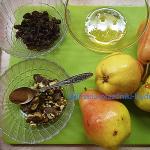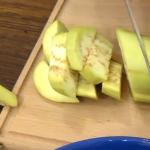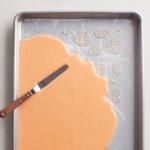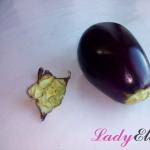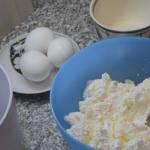Japanese biscuit. Japanese sponge cake "Castella": recipe
Japanese cotton sponge cake is a very unusual baked product. We're sure you've never made a biscuit like this before. It tastes somewhat like bird's milk, just as tender, moist and porous. The biscuit turns out so delicious that not a crumb remains of it. Preparing a biscuit is simple, the main thing is to maintain the correct temperature when baking.
Required Products
- 110 grams wheat flour
- 50 milliliters vegetable oil
- 80 milliliters milk
- 5 yolks
- 1 chicken egg
- 5 proteins
- half a teaspoon of lemon juice
- a pinch of salt
- 1 teaspoon vanilla sugar
- 90 grams of sugar
Cooking process
- Heat the vegetable oil until warm and pour into a bowl. And then sift the wheat flour into it.
- Pour warm milk into the resulting mass and mix until smooth.
- Then add the yolks and chicken egg to the dough and mix again.
- In another bowl, beat the whites with a pinch of salt, vanilla sugar and lemon juice. Add sugar there too. And we continue to beat the whites for another 5-6 minutes until stable peaks appear.
- We combine the protein and yolk mass, doing this carefully with a spatula.
- Take a baking pan, line it with parchment paper and pour the dough into it. Place the mold on a baking sheet into which we pour warm water.
- Bake the prepared biscuit in an oven preheated to 170 degrees for 20 minutes. Important! Do not open the oven during baking.
- After the allotted time, reduce the baking temperature to 150 degrees. And continue baking the biscuit for another 50-60 minutes.
- When the biscuit is already cooked, turn off the oven. But we don’t take it out, but leave it there until it cools almost completely (15-20 minutes.)
- Remove the finished and slightly cooled sponge cake from the mold, cool completely, then cut and serve.
You can serve this sponge cake with delicious chocolate coffee. You can prepare it according to the recipe from our website.
Anyone who has tried Japanese sponge cake at least once in their life will agree that this product is worthy of special attention. Created many centuries ago, it is still very popular not only in its own country, but also abroad.
Honey "Castella"
Originally, Japanese sponge cake was made from eggs, sugar, flour and starch syrup. Over the years, the composition of the dessert has changed due to the special food preferences of the inhabitants of this country. Over time, Europe began to appreciate the taste of this extraordinary dish. Today, any housewife can please her household and prepare an original Japanese sponge cake using the following basic ingredients: 8 eggs, 100 grams of milk, 300 grams of brown sugar, 200 grams of flour and 150 grams of honey.
This dessert is easy to prepare:
- First you need to sift the measured amount of flour. The procedure must be repeated three times so that the product can be “saturated” with oxygen as much as possible.
- Dilute honey in milk until completely dissolved.
- Beat eggs with sugar. The process must be carried out in a water bath for 15 minutes. During this time, the temperature of the mass should reach 60 degrees.
- Place the egg mixture in the bowl of a food processor and continue beating until it has completely cooled.
- Pour milk with honey dissolved in it.
- Gradually add flour without stopping stirring.
- Cover the mold with parchment and then pour the prepared mixture into it.
- Excess air must be removed from the mixture. To do this, you need to hit the form once on the table.
- The biscuit should be baked in the oven at 180 degrees for 50 minutes.
- Place the finished product in a plastic bag and refrigerate for several hours. This is necessary so that it becomes more moist and dense.
The finished biscuit is cut into small rectangles. In order not to damage the structure of the product, it is better to do this with a sharp knife with a grooved blade.
The history of the popular biscuit in Japan dates back to the 16th century. It was then that merchants from Portugal first landed off the coast of Nagasaki Island. Along with tobacco, guns and various provisions, they brought with them a very tasty biscuit. Local residents liked the unusual product. It began to be called “bread from Castile”, and for short - “castella”. But in those days, it was not so easy for the Japanese to prepare it themselves due to the high prices for sugar in the country. That is why local chefs began to develop new recipes for the production of “overseas delicacies”. This is probably why the country still believes that the most delicious Japanese biscuit is baked in Nagasaki. Today this dish is popular in many countries around the world. True, it is prepared mainly at home or in small bakeries. Making castella on a production scale is very difficult. This product is very capricious and sensitive to any changes in humidity or temperature.
Original base
The famous oriental biscuit is good not only for tea. It can be an excellent base for preparing other desserts. But first you need to bake the Japanese sponge cake itself. The recipe for its preparation is, in principle, simple. To work, you will need the following set of products: for 130 milliliters of milk - 85 grams of flour, 70 grams of butter, 80 grams of sugar, food coloring (if desired), 1 chicken egg, and another 165 grams of whites and 120 grams of yolks.

The method of preparing the product includes the following stages:
- Pour milk into a saucepan and put butter in it. Place the container on the fire and bring its contents to a boil.
- Stirring constantly, slowly add flour and boil the dough.
- Preheat the oven to 170 degrees.
- Transfer the finished dough into a food processor and mix slightly until it cools.
- Add egg and yolks. If you plan to make a colored sponge cake, then the dye should be introduced at this stage.
- Separately, beat the whites with sugar with a mixer.
- Combine both masses. You need to work with a regular spatula.
- Then beat the resulting mixture with a food processor for 2 minutes.
- Line a baking tray with special baking paper.
- Pour the mixture into a thin layer and place in the oven for 15 minutes.
The result is a thin, delicate and very soft sponge cake that can remain that way for several days.
homemade baking
For novice housewives, we can offer a simplified version. By following the simplest steps, they can get a real Japanese sponge cake. The recipe is extremely simple and only requires the following ingredients: for 2 eggs - 70 grams of flour, a pinch of salt, 2 tablespoons of water (or milk) and honey, 63 grams of sugar (including 13 grams for sprinkling the mold).
Operating procedure:
- If there is no special mold in the house, then you can make it yourself. You must first build a rectangular box from thick paper. The outside must be wrapped in foil, and the inside must be lined with clean paper.
- Beat eggs in a deep bowl.
- Gradually add sugar to them.
- Place the container in a saucepan with water heated to 50 degrees and mix its contents thoroughly again.
- Separately, dilute the honey with water (or milk), and then add it to the egg mixture.
- Combine salt with flour. Add the dry ingredients into the container, portionwise, stirring the contents with a wooden spatula.
- Pour the mixture into a prepared form and bake in the oven at 160 degrees. Check readiness with a wooden stick or toothpick.
For better baking, the pan should be placed on the bottom shelf. If the surface of the biscuit turns brown very quickly, you can cover it with a piece of foil.
Chiffon sponge cake
In cooking, there is another option for preparing a biscuit with a similar consistency. It was created much later, in 1927, and was called “chiffon”. For comparison, consider this sponge cake recipe. In the oven, regular muffin tins are often used to bake it. True, in this case the composition of the ingredients will be different: for 200 grams of flour - 2.5 teaspoons of baking powder, 5 eggs (plus 1 more white), 210 grams of sugar, 135 milliliters of water, 5 grams of salt, 2 grams of citric acid and 90 milliliters of olive oil.

Cooking method:
- The first step is to preheat the oven. The temperature inside it should be from 160 to 170 degrees.
- Then you need to break the eggs, separating the yolks from the whites.
- Pour the sifted flour into a deep bowl.
- Add the rest of the dry ingredients (salt, sugar and baking powder) there.
- Make a depression in the middle of the “slide”, and then pour water with oil and yolks into it. Beat them in with a whisk for 1 minute until the mixture becomes homogeneous.
- In another container, use a mixer to turn the whites into a dense foam.
- Gradually add citric acid and sugar to them. You need to beat for a long time until you get characteristic peaks.
- Fold the whites into the egg mixture little by little.
- Pour the finished dough into the mold and place it in the oven for 50 minutes.
Many people prefer this particular biscuit recipe. In the oven it turns out very soft and fluffy. In addition, the product cuts perfectly and does not even crumble.
Alternative option
There is another recipe with which you can also make an excellent Castella sponge cake. To do this you will need: one and a half glasses of flour, 7 eggs (plus 3 more yolks), 50 grams of any vegetable oil (flavorless), 75 grams of honey, 5 grams of salt and 300 grams of sugar.

The process of preparing such a biscuit is somewhat similar to that used in the previous versions:
- Pour the pre-sifted flour into a bowl along with salt.
- Beat the remaining ingredients (except for the oil) with a mixer in another bowl.
- Place this container in a pan of boiling water and continue whisking for 10 minutes. The sugar should dissolve completely.
- Gently fold in the flour.
- Separate part of the dough and grind it with butter, then return it back and make the final knead.
- Transfer the mixture into the mold.
- Bake for 15 minutes in the oven at 170 degrees.
- Make the flame smaller. Continue baking for another 45 minutes at 150 degrees.
It is better to cool such a biscuit directly in the mold.
Chocolate treat
Those who like the aroma of cocoa can prepare an oriental-style chocolate dessert at home. To ensure that the taste of the finished product is close to the original, you need to prepare the sponge cake in Japanese style. The following composition is suitable for this:
105 grams of eggs and 15 grams of yolks only, 10 grams of whole milk, glucose (or liquid honey) and cocoa powder, 80 grams of sugar, 25 grams of corn oil, 50 grams of flour, a pinch of salt, soda and vanillin.

Cooking method:
- First, you need to heat the butter, and then add cocoa to it and mix.
- Pour in milk.
- Add salt and vanilla. After stirring, wait until the mixture has cooled completely.
- Separately, beat the eggs with honey, adding the yolks.
- Without stopping, add sugar little by little. You should get an airy foam mass. But they shouldn't be. Therefore, stirring must be continued with a hand whisk.
- Add cocoa butter to the prepared mixture.
- Add flour slowly, stirring thoroughly so that no lumps remain.
- Pour the dough into a mold lined with parchment.
- Bake for 5 minutes in the bottom of the oven at 170 degrees. After this, you need to move the form a little higher and wait another 27 minutes.
After cooling, the finished dessert can be eaten. If you pour soft cream over it, you will get a wonderful cake.
Delicacy of cotton
In small cafes, the Japanese often serve the most delicate dessert with a wonderful silky texture. It is sometimes called "cotton". Japanese puffed sponge cake is prepared here from the following products: 3 eggs, 225 grams of cream cheese, zest of half a lemon, 100 grams of cream (10%) and sugar each, a teaspoon of vanilla, 30 grams of flour and rice starch.

Cooking process:
- Wrap the outside of the baking dish with foil. The inside should be coated with oil and covered with thick paper.
- Preheat the oven to 180 degrees.
- Boil one and a half liters of water.
- Divide the eggs into yolks and whites.
- Bring the cream to a boil in a saucepan.
- Grind some of the sugar with the yolks until white.
- Add hot cream in a thin stream.
- Mash the cheese and add it in parts to the egg mixture. Whisk until smooth.
- Use a mixer to turn the whites into foam. Without stopping stirring, add sugar.
- Add starch, flour, vanilla and zest to the creamy mixture.
- Add egg whites and sugar gradually.
- Transfer the dough into the mold. In order for large air bubbles to come out of it, the container must be lifted and sharply hit on the table.
- Bake in the oven in a water bath for 5 minutes.
- Reduce temperature to 160 degrees and wait another 45-55 minutes. The finished biscuit should spring back in the center.
- Turn off the fire. Remove the pan from the water bath and leave it to cool in the oven with the door open.
In just 40 minutes the dessert will be ready to eat.
Anyone who has tried Japanese sponge cake at least once in their life will agree that this product is worthy of special attention. Created many centuries ago, it is still very popular not only in its own country, but also abroad.
Originally, Japanese sponge cake was made from eggs, sugar, flour and starch syrup. Over the years, the composition of the dessert has changed due to the special food preferences of the inhabitants of this country. Over time, Europe began to appreciate the taste of this extraordinary dish. Today, any housewife can please her household and prepare an original Japanese sponge cake using the following basic ingredients:
Ingredients
- 8 eggs
- 100 grams of milk,
- 300 grams of brown sugar,
- 200 grams of flour
- 150 grams of honey.
Preparation
- First you need to sift the measured amount of flour. The procedure must be repeated three times so that the product can be “saturated” with oxygen as much as possible.
- Dilute honey in milk until completely dissolved.
- Beat eggs with sugar. The process must be carried out in a water bath for 15 minutes. During this time, the temperature of the mass should reach 60 degrees.
- Place the egg mixture in the bowl of a food processor and continue beating until it has completely cooled.
- Pour milk with honey dissolved in it.
- Gradually add flour without stopping stirring.
- Cover the mold with parchment and then pour the prepared mixture into it.
- Excess air must be removed from the mixture. To do this, you need to hit the form once on the table.
- The biscuit should be baked in the oven at 180 degrees for 50 minutes.
- Place the finished product in a plastic bag and refrigerate for several hours. This is necessary so that it becomes more moist and dense.
The finished biscuit is cut into small rectangles. In order not to damage the structure of the product, it is better to do this with a sharp knife with a grooved blade.
The history of the popular biscuit in Japan dates back to the 16th century. It was then that merchants from Portugal first landed off the coast of Nagasaki Island. Along with tobacco, guns and various provisions, they brought with them a very tasty biscuit. Local residents liked the unusual product. It began to be called “bread from Castile”, and for short – “castella”. But in those days, it was not so easy for the Japanese to prepare it themselves due to the high prices for sugar in the country.
That is why local chefs began to develop new recipes for the production of “overseas delicacies”. This is probably why the country still believes that the most delicious Japanese biscuit is baked in Nagasaki. Today this dish is popular in many countries around the world. True, it is prepared mainly at home or in small bakeries. Making castella on a production scale is very difficult. This product is very capricious and sensitive to any changes in humidity or temperature.
Original base
The famous oriental biscuit is good not only for tea. It can be an excellent base for preparing other desserts. But first you need to bake the Japanese sponge cake itself. The recipe for its preparation is, in principle, simple. To work you will need the following set of products:

Ingredients:
- 130 milliliters milk
- 85 grams of flour,
- 70 grams of butter,
- 80 grams of sugar, food coloring (if desired),
- 1 chicken egg,
- 165 grams of protein
- 120 grams of yolks.
Preparation:
- Pour milk into a saucepan and put butter in it. Place the container on the fire and bring its contents to a boil.
- Stirring constantly, slowly add flour and boil the dough.
- Preheat the oven to 170 degrees.
- Transfer the finished dough into a food processor and mix slightly until it cools.
- Add egg and yolks. If you plan to make a colored sponge cake, then the dye should be introduced at this stage.
- Separately, beat the whites with sugar with a mixer.
- Combine both masses. You need to work with a regular spatula.
- Then beat the resulting mixture with a food processor for 2 minutes.
- Line a baking tray with special baking paper.
- Pour the mixture into a thin layer and place in the oven for 15 minutes.
The result is a thin, delicate and very soft sponge cake that can remain that way for several days.
Simple Japanese sponge cake recipe
For novice housewives, we can offer a simplified version. By following the simplest steps, they can get a real Japanese sponge cake. The recipe is extremely simple and only requires the following ingredients:

Ingredients
- for 2 eggs
- 70 grams of flour,
- a pinch of salt,
- 2 tablespoons each of water (or milk) and honey,
- 63 grams of sugar (including 13 grams for sprinkling).
Preparation
- If there is no special mold in the house, then you can make it yourself. You must first build a rectangular box from thick paper. The outside must be wrapped in foil, and the inside must be lined with clean paper.
- Beat eggs in a deep bowl.
- Gradually add sugar to them.
- Place the container in a saucepan with water heated to 50 degrees and mix its contents thoroughly again.
- Separately, dilute the honey with water (or milk), and then add it to the egg mixture.
- Combine salt with flour. Add the dry ingredients into the container, portionwise, stirring the contents with a wooden spatula.
- Pour the mixture into a prepared form and bake in the oven at 160 degrees. Check readiness with a wooden stick or toothpick.
For better baking, the pan should be placed on the bottom shelf. If the surface of the biscuit turns brown very quickly, you can cover it with a piece of foil.
Chiffon sponge cake
In cooking, there is another option for preparing a biscuit with a similar consistency. It was created much later, in 1927, and was called “chiffon”. For comparison, consider this sponge cake recipe. In the oven, regular muffin tins are often used to bake it. True, in this case the composition of the ingredients will be different.
To prepare a real biscuit originally from distant Japan, you need only 5 ingredients.
Cooking technology:
- Sift the flour 3 times. This is one of the key requirements, do not ignore it.
- Dissolve honey in milk.
- Beat the eggs into a bowl, add sugar, place in a water bath and start beating with a mixer until the temperature reaches 60°. Measure the temperature with a kitchen thermometer. This will take approximately 15 minutes.
- Remove the eggs from the water bath and continue to run the mixer until they cool.
- With the mixer running, pour in the milk and honey.
- Add sifted flour in small portions. Mix the dough with a rubber or silicone spatula.
- Cover the bottom of the mold with parchment. Pour over the dough. Tap the mold well on the table once. This will remove excess air. You cannot tap several times, otherwise the biscuit will not fit.
- Bake the cake at 180° until done, about 50 minutes.
Immediately remove the finished biscuit from the mold, place it in a plastic bag and tie it tightly. Keep it in the bag for 2 hours.
How do Japanese sponge cakes differ from European ones?
The classic sponge cake, which is baked in Europe, is very light and airy; it is also called “sponge cake”, that is, a sponge cake, due to its special texture. But in Japan, biscuits, on the contrary, are very dense and moist. Outwardly, the European and Japanese versions of this cake may seem the same, but after taking just a bite, you will feel the difference.
This biscuit texture is achieved thanks to a special set of ingredients and cooking technology. Since strict maintenance of a certain temperature is required, the dessert is usually made on an industrial scale, but it can also be made at home. Don't be discouraged if it doesn't work out the first time. With a little practice, you can pamper your family with a delicious treat.
Be sure to try this dessert. Despite the simple set of ingredients, the cake turns out to be very unusual. It's definitely not like the biscuits you've tried before.
It turns out that biscuits are baked even in Japan. A simple pastry made from beaten eggs has circled the earth. What a surprise.
And this is how it all started. Once upon a time, the Portuguese, at the dawn of their achievements and strength, sailed to the shores of Japan, straight to Kyushu (or Nagasaki, different sources say differently). They soon established successful trade relations with the population and also began to conduct missionary activities. Thanks to this, the Japanese discovered many useful things: guns for war, gourds for food, tobacco for false pleasure and Kasutera biscuit for real pleasure. Over hundreds of years, Kastella has changed and turned into a Japanese dessert.
Today, the sponge cake is prepared with sugar and honey or syrup (for example, corn syrup). This is why it comes out moist with a dark brown top and sides, which distinguishes it from its Western relatives.
Most often, Kasutera is served with whipped cream or frosting.
Making Japanese sponge cake.
Your first task in the kitchen is to prepare the mold. Do you know that in Japan Kasutera is made in a special square wooden mold? Of course, it’s difficult to find such a mold here, but we can replace it with a regular square one for cupcakes. I used non-stick coating.
Before pouring the dough, line the mold with parchment. To do this, measure out the required piece, and then make cuts on four sides (see photo below). Before placing the parchment in the mold, spray it with a little oil.
First, sift the flour (200 g) so that it is in sight. Then combine honey (5 tbsp) and warm water (2 ½) and, of course, mix well.
To check if the eggs are beaten enough, you need to run the tip of a knife across the surface. If the mark stays and doesn't disappear quickly, it's whipped as you need it to be.
Next, add honey and water to the eggs and mix with a mixer at minimum speed for 30 seconds.
And finally, pour in the flour in three approaches, each time mixing with the mixer also at low speed.
Place the dough in the mold and draw zigzags by dipping a wooden stick into the dough. Then throw a little shape of 3-4 cm in height. All this must be done to allow excess air to escape.
Bake the honey biscuit at 160 - 180 C until ready.
When you are finished baking, remove the Kasutera from the oven. Mix 1 tbsp. l. honey with ½ tbsp. l., and then grease the top of the sponge cake with this solution. When it has cooled, wrap it in cling film and leave it overnight. During this time it will become more moist and fragrant.
Note:
If your baking dish is small, you can divide all the ingredients in half and make a smaller portion of dough.
Ingredients
- Honey: 6 tbsp. l.
- Flour: 200 g
- Sugar: 218 g
- Eggs: 6 pieces
- Warm water 3 tbsp. l.



